|
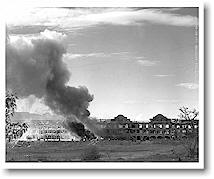
59th CA Barracks; Mile-Long Barracks; Explosion of the Ammunition Dump
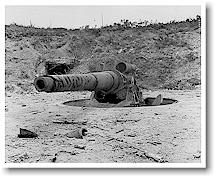
Battery Smith, Smith Magazine
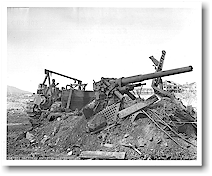
Battery Boston, 3" AA
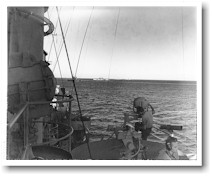
USS Phoenix, USS Boise, USS Denver, USS Cleveland & USS Montpelier set
out towards Corregidor
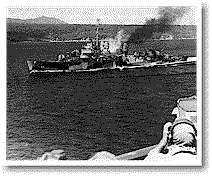
USS HOPEWELL (DD-681), damaged by Japanese Artillery in North Channel |

|
On the 25th the American troops decreased
this distance about 1,000 yards. That night's lines ran from
Cavalry Point, on the north shore, south-southeast some 700
yards to the south shore at Monkey Point. The 503d had
encountered stiff resistance, including some banzai charges,
near Monkey Point, and during the afternoon many of the Japanese
still remaining on the tail attempted to escape by swimming to
Bataan or Caballo Island. Those refusing to surrender to
cruising PT's or engineer LCM's were killed by the boats'
gunners and strafing planes.
As dark came on the 25th, Rock Force was
confident that the morrow would see the end of significant
resistance on Corregidor. The 3d Battalion, 34th Infantry, would
not be there to share in the glory, for with the 24th Division
assembling on Mindoro for operations in the southern
Philippines, the battalion had to leave. Its place was taken by
the 2d Battalion of the 38th Division's 151st Infantry, which
moved over from Mariveles.
Shortly after 1100 on 26 February the
Japanese on Corregidor executed their final, suicidal tour de
force, blowing an underground arsenal at Monkey Point amid
scenes of carnage on both sides. As the dust from terrific
explosions settled, a hollow appeared where a small knoll had
previously stood. Debris had flown as far as Topside where one
man, almost a mile from the explosion, was injured by flying
rock. Other debris hit a destroyer 2,000 yards offshore. A
medium tank was hurled 50 yards through the air, most of its
crew killed. 16 Bits
and pieces of American and Japanese troops splattered the
ground; rock slides buried alive other men of both forces. Over
200 Japanese were killed outright, while Rock Force lost some 50
men killed and 150 wounded. Medics took an hour and a half to
clear the casualties from the area, and at the end of that time
one medical officer, an eyewitness to the horrors, could only
report:
As soon as I got all the casualties off,
I sat down on a rock and burst out crying. I couldn't stop
myself and didn't even want to. I had seen more than a man
could stand and still stay normal. . . . When I had the
cases to care for, that kept me going; but after that it was
too much. 17
The explosion marked the end of organized
resistance on Corregidor, and by 1600 on 26 February elements of
the 503d Parachute Infantry had reached the eastern tip of the
island. The battle was over except for mopping up small groups
of Japanese holed up in waterline caves. This process the 503d
Infantry had to hurry along since the regiment had been alerted
to get back to Mindoro no later than 10 March in order to make
ready for participation in operations to clear the southern
Philippines.
By 2 March General Hall and Colonel Jones had
concluded that mopping up had progressed to the point that they
could set an official terminal date for the Corregidor
operation. Casualties to 2 March, including those from the
parachute drop, numbered over 1,000 killed, wounded, injured,
and missing. (Table
7) Japanese losses--actually counted--numbered about 4,500
killed and 20 captured. An additional 200 Japanese were
estimated to have been killed while trying to swim away, and it
was thought that at least 500 might have been sealed in caves
and tunnels; a few remained alive in various hideaways. 18
On 2 March 1945 General MacArthur returned to
Corregidor, just nine days short of three years after his
departure. A simple yet impressive flag-raising ceremony was
held. The theater commander and those members of his staff who
had shared the terrible days of 1942 on The Rock must have had
large lumps in their throats as Colonel Jones stepped forward,
saluted, and reported: "Sir, I present to you Fortress
Corregidor." 19
|
TABLE 7
CASUALTIES IN CORREGIDOR
OPERATIONS TO MARCH 1945
|
Unit |
Killed |
Wounded |
Injured |
Missing |
Total |
|
|
503d Parachute
RCT |
165 |
285 |
330 |
0 |
780 |
|
3d Battalion,
34th Infantry
(Reinforced) |
38 |
150 |
10 |
5 |
203 |
|
2d Battalion,
151st Infantry |
7 |
15 |
0 |
0 |
22 |
|
Total |
210 |
450 |
340 |
5 |
1,005 |
Source. Unit
records cited in preceding
footnotes. |
|
   |
|
|

|
|
|


